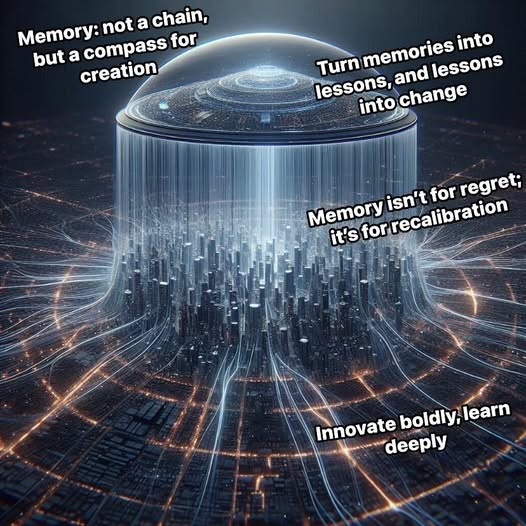
In the heart of a sprawling metropolis known as Chronos City, where skyscrapers pierced the clouds and neon lights painted the streets in vibrant hues, there lived a young engineer named Kian. Chronos City was a marvel of technology, its streets filled with self-driving vehicles, holographic advertisements, and AI-driven systems that managed everything from traffic to weather. But Kian had a problem: he kept making the same mistakes in his work. Whether it was a miscalculation in his blueprints or a misstep in his designs, he found himself stuck in a loop of errors, unable to break free.
Kian’s mentor, an elderly inventor named Dr. Elara Voss, often told him, “Memory is not a museum of the past; it’s a workshop for the future. If you don’t learn from your mistakes, you’ll keep building the same broken bridges.”
One day, the city unveiled its latest innovation: the Memory Core, a massive AI system designed to manage the city’s infrastructure. The Memory Core was unlike any other machine. It didn’t just store data; it learned from it. If a traffic algorithm caused a gridlock, the Core would analyze the problem, adjust its parameters, and ensure the mistake didn’t happen again. If a power grid failed, it would identify the flaw and redesign the system to prevent future outages. The Memory Core was action-oriented, using its vast memory to improve the city in real time.
Kian was fascinated but also frustrated. “How can a machine learn from its memory so effortlessly, while I keep repeating the same mistakes?” he muttered to himself.
Dr. Voss overheard him and said, “The Memory Core doesn’t dwell on the past; it acts on it. It analyzes, adapts, and moves forward. Why can’t you do the same?”
Determined to prove himself, Kian decided to test his skills against the Memory Core. The city had announced a competition to design a new public transportation system, and Kian entered, determined to create something revolutionary. He worked tirelessly, but as always, he made mistakes. His initial designs were flawed, his calculations off by fractions that caused major issues. Frustrated, he considered giving up.
But then he remembered Dr. Voss’s words. Instead of ignoring his errors, he decided to study them. He asked himself, What went wrong? Was it the material choice? The structural design? The timing of the routes? He realized he had been too focused on grand ideas and not enough on practical details.
Meanwhile, the Memory Core had also entered the competition, submitting a design that was flawless in its precision. Kian requested access to the Core’s logs, curious to see how it had avoided the same pitfalls. To his surprise, the Core had made mistakes too—hundreds of them. But each time, it had analyzed the error, learned from it, and adjusted its approach. Kian began to see memory not as a burden but as a tool. He started applying the same method, using his past mistakes to guide his future actions.
As the days turned into weeks, Kian’s design evolved. He incorporated the lessons he had learned, refining his plans with each iteration. When the day of the competition arrived, the judges were astounded. The Memory Core’s design was, as expected, a masterpiece of efficiency. But Kian’s design was something else entirely. It was innovative, bold, and deeply human, with solutions that only someone who had struggled and grown could have conceived.
The judges declared a tie, and Kian was celebrated as a pioneer of action-oriented memory. Dr. Voss smiled proudly, saying, “You’ve learned what the Memory Core already knew: the past is not a chain but a compass.”
From that day on, Kian became known as the Memory Engineer. He taught the people of Chronos City to embrace their mistakes, not as failures but as stepping stones. “Remember to act,” he would say. “Let your past guide your hands, and your future will be a masterpiece.”
And so, Chronos City thrived, its streets filled with the hum of progress and the glow of innovation. The Memory Core remained at the heart of the city, not as a replacement for human ingenuity but as a reminder that even machines could teach the value of learning from the past.
And Kian? He continued to build, his designs growing bolder and more brilliant with each passing day, knowing that every mistake was a thread in the tapestry of his success.

